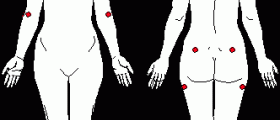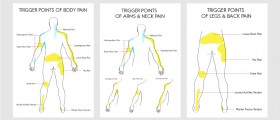
Tension neck syndrome refers to a condition whereby pain and stiffness occur in the neck. Upon further examination, palpation tenderness in the trapezius muscle is usually discovered. Headache and fatigue are other indications of the presence of the condition. There is normally a trigger point of the condition, from whence the pain and stiffness originates. This condition is common amongst office and factory workers due to the nature of the jobs. Commonly affected are those who work on assembly lines, as cashiers and as packers.
Symptoms
The most obvious symptom of the condition is an aching discomfort that is felt at the back of the neck and the upper back. There might also be headaches, which can occur as a result of tension in the neck muscles. One might also experience muscle spasms in the neck and dull pain in the upper arm, elbow, forearm and hands.
Causes
There are many possible causes of this condition, including chronic strain, poor posture and even psychogenic factors such as stress, depression and tension. The condition might also occur due to muscular and mental fatigue as a result of repetitive arm and hand work. One theory points to the load that is put on our bodies as a result of repetitive motions involving any part of the time. Unnatural arm position and increased muscular workload are often factors. Other factors, such as working environment, also played a part in the development of the condition. Constant elevation of the arms is another possible cause of the onset of the condition.
The usage of a computer mouse has been associated with neck and shoulder pain. The connection between the two is possible but not certain. It has been found that the prevalence of the condition amongst those who use a mouse for more than 25 hours per week is higher than normal. Those who use a computer as part of their job are believed to be at a higher risk of developing the condition.
Generally, the condition is believed to be caused by localized muscle fatigue. This fatigue can occur due to repetitive motion or static, sustained contraction. Lack of oxygen supply and the accumulation of metabolic end products are thought to be primary causes of muscle fatigue.
These primary causes can be worsened or developed by other factors, such as the psychological constitution of the sufferer. It is thought that the pain can be enhanced by motivational or social factors. Many findings with regard to this condition are inconsistent, but it is generally believed that the psychological and physical condition of the sufferer both contribute to its development. It has been established, however, that the connection between workload and muscle fatigue does exist.


-Causes,-Symptoms,-Diagnosis,-Treatment_f_280x120.jpg)









-vs-Trigger-Points-(Myofascial-Pain-Syndrome)_f_280x120.jpg)




Your thoughts on this
Loading...